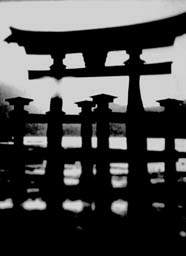|
|
AUTHOR |
|

|
|
Ing. arch. MgA. Osamu Okamura, graduate of
the Faculty of Architecture at the Czech
Technical University (ČVUT) in Prague and of the Academy
of Fine Arts, School of Architecture of Prof. E. Prikryl, in Prague and School of
Conceptual Art of Prof. M. Sejn; with a special interest in intercultural studies. The
author visited Japan several times,
from 1991 is a member of The Czech–Japanese Society and is able to communicate in Czech,
Slovak, English, French and Russian. |
|

|
|
|
|
PUBLICATIONS ON THE THEME
|
|

|
|
“Japonský
vesnický dům (a česká chalupa?)” in
Architekt magazine XLIII, 1997, No. 16-17, p. 62-63 in Kokoro, spring-summer 1997, p. 20-22 |
|
„Arts and Crafts,
Frank Lloyd Wright a vliv japonské kultury u počátku moderny“ chapter
(p. 38-40) in: Oldřich Ševčík: „Problémy moderny a postmoderny“,
Vydavatelství ČVUT Praha 1998, 3. přepracované vydání
|
|
"Knihy o
japonské architektuře a zahradách ve veřejných knihovnách ČR" vlastním
nákladem 1998 |
|
Kontinuita životního prostoru. O vztahu japonské architektury k
přírodnímu prostředí. publikováno v: Sborník přednášek: Zahradami napříč
Asií, str. 43-48. Vydala Sekce bonsají a zahrad Česko-japonské společnosti, Praha
2001 a v: časopis STAVBA , 2001, č. 3, str.18-21; |
|

|
|
|
|
REALIZED MULTICULTURAL
PROJECTS |
|

|
|
“The
place is built…”, Prague 1997 (with Josée Dionne, Frauke Dirksen, Yvette
Vašourková), published in Architekt magazine
XLIII, 1997, No. 9, p. 5 |
|
“The
Holocaust Memorial”, Jerusalem 1997 (with Petr Husák and Maria-Luisa Miccoli), published
in Architekt magazine XLIV, 1998, No. 1-2, p. 10-11 |
|
Invited address “The Holocaust and
ethics in architecture”, at Prague Forum
2000 International Conference of Leading Intellectual Figures, organized and sponsored
by The Sasakawa Peace Foundation. 3-7/9 1997, Prague Castle. |
|
"Table Event", "Cinema
Event", "Shouting Event", "Kanji Event" (in cooperation with
David Mauas and Adam Vačkář - "Action Group"); "Document on living
conditions of local Roma family in Terezín" (in cooperation with David Aronowitsch
and Krista Hegburg). International architecture workshop "Locating Terezín" at Terezín, organised
by Terezín Foundation and Arche Wien, Platform for Intercultural Projects, 15-25/7 1999. |
|
International interdisciplinary open-air
workshop "Bohemiae Rosa Project", Site
Body Exploration III, Bohemian Karst / Berounka River Valley, organised by Academy of Fine
Arts in Prague, Hermit Foundation and The Centre for Metamedia in Plasy, Czech Republic,
3-16/8 1999 |
|
Japanese
Restaurant Koto in Prague: Tatami-room interior design, graphic style, internet pages
(in cooperation with Daniel Ziss), summer 1999 |
|
"Incense Field". Polyphonic Arts
in Prague, Czech-Japanese Art Project, Střelecký ostrov, 25-27/8 1999. |
|
"Tchechisches
Zentrum Berlin": Interior design of the main hall for Ministry of Foreign
Affaires of Czech Republic (in cooperation with Daniel Ziss). Work in Progress.
|
|
|
|
REFERENCE
|
|

|
|
For further reference about lectures on
Japanese architecture you can contact the cultural department of the Japanese Embassy in
Prague 1, Maltézské nám. 6, 118 01, Czech Republic. Tel. Embassy: ++420-257533546 or
directly cult. dept.: ++420-257011097 and Fax: ++420-257532377 or cult. dept.
++420-257537720 |
|
|
|
CONTACT |
|

|
|
If this project raises your interest,
contact the author for details. |
|

|
|
Ing. arch. MgA. Osamu Okamura
Mobile: ++420-723912666, E-mail: <okamura@quick.cz>
|
|
|
|

|
|
|
|

|
![[CNW:Counter]](http://counter.cnw.cz/denisa.cgi?arch&5&FFFFFF&000000&on)
|




